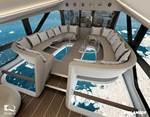Hybrid Air Vehicles awarded production organization approval
Airlander 10 begins 2019 in good position to move forward into a type certification program.
The Civil Aviation Authority (CAA, Crawley, UK) has awarded Hybrid Air Vehicles Ltd. (HAV, Shortstown, Bedford, UK) a Production Organization Approval (POA). Following the successful award of a Design Organization Approval (DOA) from the European Aviation Safety Agency (EASA, Cologne, Germany) in Oct. 2018, this latest achievement sees HAV starting 2019 in a strong position to launch production of its Airlander 10.
A POA considers the manufacture and assembly aspects of aircraft production. This includes supply chain management, processes relating to manufacture and assembly, and the production facility itself. Both the DOA, which covers design activities and flight test, and the POA, covering manufacture and assembly, are required to move forward into a type certification program with the production Airlander 10.
“The POA approval is a significant milestone for HAV. It is the culmination of months of hard work and focused effort,” says David Lindley, HAV’s Head of Aviation Safety & Quality Assurance. “It demonstrates that the safety, quality assurance and supply chain management processes are in place, along with the production facility.”
“Successfully being awarded our POA in the same year as our DOA is fantastic,” adds executive director Nick Allman. “The POA is the regulator’s stamp of approval for us to move ahead with the productionization of Airlander 10 on the path to type certification.”
The Airlander’s hull skin reportedly is made from a combination of materials, including a woven liquid crystal polymer fiber from Vectran (Kuraray, Tokyo, Japan), woven aramid fiber, polyvinyl fluoride film (PVF) known as Tedlar (DuPont, Wilmington, DE, US), and Mylar polyethylene terephthalate (PET) film from DuPont Teijin films (Luxembourg) combined with polyurethane film to create a gas barrier. Composite payload modules attach to the bottom of the hull, reportedly using cables that attach to the rigid skin. HAV has worked with Forward Composites (Huntingdon, UK) on the composite designs. The carbon fiber composite elements help minimize the weight of attached modules.
Related Content
-
Development of a composite liquid hydrogen tank for commercial aircraft
Netherlands consortium advances cryogenic composites testing, tank designs and manufacturing including AFP, hybrid winding, welding of tank components and integrated SHM and H2 sensors for demonstrators in 2025.
-
The potential for thermoplastic composite nacelles
Collins Aerospace draws on global team, decades of experience to demonstrate large, curved AFP and welded structures for the next generation of aircraft.
-
Otto Aviation launches Phantom 3500 business jet with all-composite airframe from Leonardo
Promising 60% less fuel burn and 90% less emissions using SAF, the super-laminar flow design with windowless fuselage will be built using RTM in Florida facility with certification slated for 2030.






